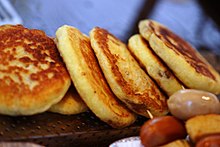Hotteok
 | |
| Type | Pancake |
|---|---|
| Place of origin | Korea |
| Main ingredients | Dough: wheat flour, water, milk, sugar, yeast Filling: brown sugar, honey, peanuts, cinnamon |
| Hotteok | |
| Hangul | 호떡 |
|---|---|
| Hanja | 胡- |
| Revised Romanization | hotteok |
| McCune–Reischauer | hottŏk |
| IPA | [ho.t͈ʌk̚] |
Hotteok (호떡, pronounced [ho.t͈ʌk̚]) is a variety of filled Korean pancake, and is a popular street food of Korea.
Preparation
The dough for hotteok is made from wheat flour, water, milk, sugar, and yeast. The dough is allowed to rise for several hours. Handful-sized balls of this stiff dough are filled with a sweet mixture, which may contain brown sugar, honey, chopped peanuts, and cinnamon. The filled dough is then placed on a greased griddle, and pressed flat into a large circle with a special tool with a stainless steel circle and wooden handle as it cooks.[1][2]
In Korea, ready-made dry hotteok mix is commercially available in plastic packages. The mix also comes with a filling consisting of brown sugar and ground peanuts or sesame seeds.[3]
Origin

It is generally believed that hotteok originated from Chinese merchants who immigrated to Korea after the late 19th century.[4] Unlike many Chinese pancakes, which often contain savory meat fillings, hotteok are stuffed with sweet fillings, to suit Koreans' tastes.[5]
Varieties
The types of hotteok have been changing continuously although many favour the traditional cinnamon and peanut filling. Many variations have developed since the early 21st century, such as green tea hotteokphoto, pink bokbunja hotteok, corn hotteok, pizza hotteok and more.[5] Commercial "hotteok" products are developed and sold by companies "Samyang", "Ottogi" and "CJ". The products are designed to be able to cook at home.
Nutrition
Hotteok is usually eaten during the winter season. Due to its high sugar content, a single hotteok may have as many as 230 calories.[6]
Phrases using hotteok
Koreans say "The hotteok store is burning (호떡집에 불났다)" to refer to noisy situations. It is believed that the origin of this phrase is that Chinese merchants were considered very noisy by Koreans. If their Hotteok stores were burnt, the merchants must have talked to each other about the reason of fire, or the accidents, in the tonal Chinese language.[4]
See also
- Korean cuisine
- Hobbang
- Bungeoppang
- List of Korean desserts
- List of pancakes
- List of stuffed dishes
 Food portal
Food portal
References
- ^ Template:Ko Hotteok at The National Institute of the Korean Language Dictionary
- ^ Template:Ko Recipe for hotteok at Naver kitchen
- ^ Template:Ko Snack mix popularity on the rise, Yonhap News, 2010-01-07. Retrieved 2010-06-27.
- ^ a b Template:Ko 호떡, 가난한 쿨리의 가장 먹기 편한 음식, The Hankyoreh, 2012-04-27. Retrieved 2017-07-11.
- ^ a b Template:Ko Hotteok, Kyunghyang News, 2003-11-20. Retrieved 2010-06-27.
- ^ Template:Ko Winter snacks, Kukinews, 2007-01-07.
